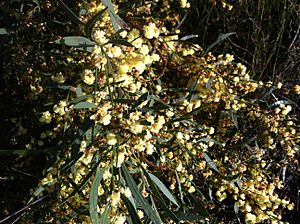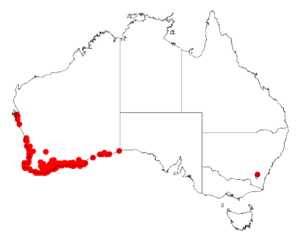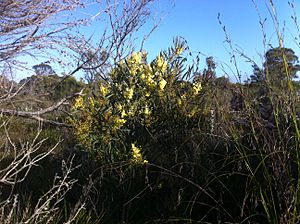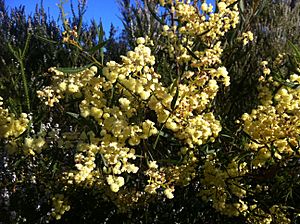Rigid wattle facts for kids
Quick facts for kids Rigid wattle |
|
|---|---|
 |
|
| Scientific classification | |
| Genus: |
Acacia
|
| Species: |
cochlearis
|
 |
|
| Occurrence data from AVH | |


The Acacia cochlearis, often called the rigid wattle, is a type of shrub. It belongs to the Acacia plant family. This plant grows naturally along the coast of Western Australia. You can find it from the Goldfields-Esperance area up to the Mid West region.
Contents
What is the Rigid Wattle?
This bushy shrub usually grows to be about 0.5 to 3 meters (1.6 to 9.8 feet) tall. Its branches have ribs and are smooth or slightly hairy. Young shoots have small leaf-like parts called Stipules. The trunk and branches have smooth bark that can be green or brown.
Leaves and Flowers
The leaves are tough and leathery. They are often attached directly to the stem without a stalk. These leaves are usually 2 to 5 centimeters (0.8 to 2 inches) long. They are also about 2 to 10 millimeters (0.08 to 0.4 inches) wide. They can be straight or slightly curved.
The rigid wattle blooms from July to October. It produces bright yellow flowers. These flowers grow in round clusters, about 4 to 5 millimeters (0.16 to 0.2 inches) across. Each cluster has 30 to 50 tiny, deep golden flowers. Many different insects help to pollinate these flowers.
Seeds and Pods
After flowering, the plant forms green-brown seed pods. These pods are long and thin, about 50 millimeters (2 inches) long. Each pod holds 10 to 15 black seeds. Most of these seeds can grow into new plants. When the seeds are ready, usually in December, the pods open up and curl back.
Where Does the Rigid Wattle Grow?
The Acacia cochlearis prefers sandy soils. It grows in coastal areas like sandplains and sand dunes. You can find it along the coast from Lancelin all the way to Israelite Bay. It can grow alone or in thick, dense groups.
How People Use Rigid Wattle
This shrub is a good choice for gardens in coastal areas. It also helps to keep sand dunes from moving. The rigid wattle grows quickly and well in stable soils. It needs some protection from strong winds. It is often planted with other plants like Acacia rostellifera and Scaevola crassifolia. If you see this plant growing well, it often means the sand dunes are healthy.
Growing Rigid Wattle from Seed
You can grow Acacia cochlearis from its seeds. Before planting, soak the seeds in hot water. You can also gently rub them with fine sandpaper. Plant them in soil that drains water well. Adding some soil from existing wattle plants can help. This transfers special bacteria called Rhizobium. These bacteria help the plant get important nutrients from the soil. Rigid wattle plants need to be in a spot that gets full sun.


